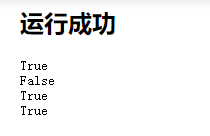1、什么是继承
在OOP程序设计中,
[ 面向对象编程(Object Oriented Programming,OOP,面向对象程序设计)是一种计算机编程架构。OOP 的一条基本原则是计算机程序是由单个能够起到子程序作用的单元或对象组合而成。]
当我们定义一个class的时候,可以从某个现有的class继承,
新的class称为子类(Subclass),
被继承的class称为基类、父类或超类(Base class、Super class)。
比如,我们已经编写了一个名为Animal的class,有一个run()方法可以直接打印:
class Animal(object):
def run(self):
print('Animal is running...')
当我们需要编写Dog和Cat类时,就可以直接从Animal类继承:
class Dog(Animal):
pass
class Cat(Animal):
pass
对于Dog来说,Animal就是它的父类,对于Animal来说,Dog就是它的子类。Cat和Dog类似。
继承有什么好处?
最大的好处是子类获得了父类的全部功能。
由于Animial实现了run()方法,因此,Dog和Cat作为它的子类,什么事也没干,就自动拥有了run()方法:
dog = Dog()
dog.run()
cat = Cat()
cat.run()
运行结果如下:
Animal is running...
Animal is running...
当然,也可以对子类增加一些方法,比如Dog类:
class Dog(Animal):
def run(self):
print('Dog is running...')
def eat(self):
print('Eating meat...')
继承的第二个好处需要我们对代码做一点改进。你看到了,无论是Dog还是Cat,它们run()的时候,显示的都是Animal is running…,符合逻辑的做法是分别显示Dog is running…和Cat is running…,因此,对Dog和Cat类改进如下:
class Dog(Animal):
def run(self):
print('Dog is running...')
class Cat(Animal):
def run(self):
print('Cat is running...')
再次运行,结果如下:
Dog is running...
Cat is running...
当子类和父类都存在相同的run()方法时,我们说,子类的run()覆盖了父类的run(),在代码运行的时候,总是会调用子类的run()。
2、Python中继承一个类
如果已经定义了Person类,需要定义新的Student和Teacher类时,可以直接从Person类继承:
class Person(object):
def __init__(self, name, gender):
self.name = name
self.gender = gender
定义Student类时,只需要把额外的属性加上,例如score:
class Student(Person):
def __init__(self, name, gender, score):
super(Student, self).__init__(name, gender)
self.score = score
一定要用 super(Student, self).__init__(name, gender) 去初始化父类,
否则,继承自 Person 的 Student 将没有 name 和 gender。
函数super(Student, self)将返回当前类继承的父类,即 Person ,然后调用__init__()方法,注意self参数已在super()中传入,在__init__()中将隐式传递,不需要写出(也不能写)。
任务
请参考 Student 类,编写一个 Teacher类,也继承自 Person。
CODE
class Person(object):
def __init__(self, name, gender):
self.name = name
self.gender = gender
class Teacher(Person):
def __init__(self, name, gender, course):
self.name = name
self.gender = gender
self.course = course
t = Teacher('Alice', 'Female', 'English')
print t.name
print t.course

3、python中判断类型
函数isinstance()可以判断一个变量的类型,既可以用在Python内置的数据类型如str、list、dict,也可以用在我们自定义的类,它们本质上都是数据类型。
假设有如下的 Person、Student 和 Teacher 的定义及继承关系如下:
class Person(object):
def __init__(self, name, gender):
self.name = name
self.gender = gender
class Student(Person):
def __init__(self, name, gender, score):
super(Student, self).__init__(name, gender)
self.score = score
class Teacher(Person):
def __init__(self, name, gender, course):
super(Teacher, self).__init__(name, gender)
self.course = course
p = Person('Tim', 'Male')
s = Student('Bob', 'Male', 88)
t = Teacher('Alice', 'Female', 'English')
当我们拿到变量 p、s、t 时,可以使用 isinstance 判断类型:
>>> isinstance(p, Person)
True # p是Person类型
>>> isinstance(p, Student)
False # p不是Student类型
>>> isinstance(p, Teacher)
False # p不是Teacher类型
这说明在继承链上,一个父类的实例不能是子类类型,因为子类比父类多了一些属性和方法。
我们再考察 s :
>>> isinstance(s, Person)
True # s是Person类型
>>> isinstance(s, Student)
True # s是Student类型
>>> isinstance(s, Teacher)
False # s不是Teacher类型
s 是Student类型,不是Teacher类型,这很容易理解。
但是,s 也是Person类型,因为Student继承自Person,虽然它比Person多了一些属性和方法,但是,把 s 看成Person的实例也是可以的。
这说明在一条继承链上,一个实例可以看成它本身的类型,也可以看成它父类的类型。
任务
请根据继承链的类型转换,依次思考 t 是否是 Person,Student,Teacher,object 类型,并使用isinstance()判断来验证您的答案。
CODE
class Person(object):
def __init__(self, name, gender):
self.name = name
self.gender = gender
class Student(Person):
def __init__(self, name, gender, score):
super(Student, self).__init__(name, gender)
self.score = score
class Teacher(Person):
def __init__(self, name, gender, course):
super(Teacher, self).__init__(name, gender)
self.course = course
t = Teacher('Alice', 'Female', 'English')
print isinstance(t,Person)
print isinstance(t,Student)
print isinstance(t,Teacher)
print isinstance(t,object)

